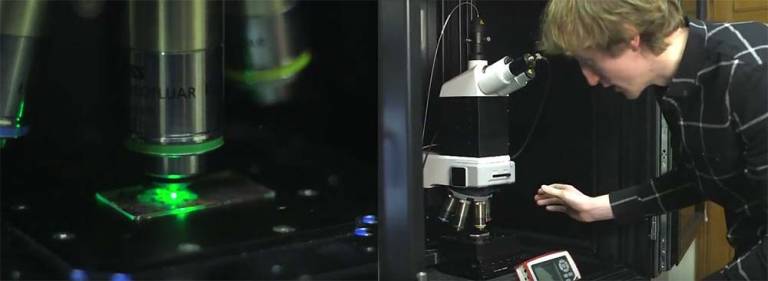World’s Oldest Fossils Unearthed
1 March 2017
Research led by Dr Dominic Papineau & Matt Dodd provide direct evidence for one of the oldest life forms on Earth - fossilized remains of microorganisms that are at least 3,770 million years old. “Our discovery supports the idea that life emerged from hot, seafloor vents shortly after planet Earth formed. This speedy appearance of life on Earth fits with other evidence of recently discovered 3,700 million year old sedimentary mounds that were shaped by microorganisms. These discoveries demonstrate life developed on Earth at a time when Mars and Earth had liquid water at their surfaces, posing exciting questions for extra-terrestrial life. Therefore, we expect to find evidence for past life on Mars 4,000 million years ago, or if not, Earth may have been a special exception.” explained first author, PhD student Matthew Dodd (UCL Earth Sciences and the London Centre for Nanotechnology).

In jasper banded iron formations (BIF) that are least 3,770 million years old, and possibly up to 4,280 million years old, we have discovered microfossils and their mineralised remains. These hydrothermal vents precipitates occur along strike from the main BIF unit in the Nuvvuagittuq Supracrustal Belt in Nunavik, Québec, Canada, which contains volcanic rocks dated directly at 4,280 million years old, an age currently debated in the scientific community.
The discovery includes microscopic filaments and tubes composed of hematite that have twisted structures, some attached to terminal knobs and/or branching. Some twisted filaments are coated with nanoscopic haematite that forms elongated tubular structures around the filaments. Notably, many of these microfossils were found in red haematite concretionary structures that deflect sedimentary laminations, and which are known to form during early diagenesis. Filaments often co-occur with micron-size grains of carbonate, apatite, and graphitic carbon. We also discovered microscopic rosettes and granules composed of minerals that contain carbonate, apatite, and graphitic carbon. Some of these occur in the vicinity of outsized apatite grains, that also contain inclusions of graphitic carbon. Lastly, in a paper published in 2011 in Nature Geoscience, our group had reported 13C-depleted organic and carbonate bulk compositions from these rocks. These geochemical, mineralogical, petrological, and sedimentological evidence prove the biological origin.
The biological origin of the filaments is confirmed by the presence of all the above features in younger BIF as well as in modern environments and experiments. We rejected the null hypothesis (i.e. that they are non-biological microfossil-like structures) because none of the known non-biological processes that can produce microbe-like structures can also explain the compositions that we observe. Instead, apatite, carbonate, and graphitic carbon are minerals expected from metamorphosed and oxidized biomass, akin to fossilised animals composed of these same minerals (e.g. animals bio-mineralise carbonate-apatite in teeth and bones). This discovery tells us that some microorganisms around hydrothermal vents have not significantly changed their morphology for 4 billion years, although we do not yet know what they were eating and breathing, and that microbial life diversified very early on. Finally, we now have a better idea of the kinds of biosignatures to look for in the geological record of Mars.
We use various imaging modes by optical microscopy and micro-Raman (in the Geological Spectroscopy Laboratory) to visualize the mineral assemblages and to determine their mineralogy. For instance, micron-size particles of graphitic carbon could only be detected and confirmed to be indigenous to the rock by using the micro-Raman imaging, which allows pixel-by-pixel analysis of a microscopic target with a spatial resolution down to about 360nm. We also used Focused Ion Beam at the London Centre for Nanotechnology to nano-fabricate microscopic mineral assemblages to visualize the petrology of graphitic carbon at the nanoscale. Finally, we used Inductively-Coupled Plasma Mass Spectrometry in the London Geochronology Centre to confirm that these chemical sedimentary rocks contain rare Earth element compositions consistent with a hydrothermal origin. Thin sections and slabs of samples were prepared in various places, including in the Rock Preparation Laboratory, and were finally polished in the Geological Spectroscopy Laboratory.

Image: Dominic Papineau and Matt Dodd in the Geological Spectroscopy Laboratory.
This research was initiated by Dr. Papineau with a 2008 field mission to the Nuvvuagittuq Supracrustal Belt, in northern Québec, Canada. In the field, he worked alone and specifically collected samples of banded iron formations to search for possible biosignatures. Dominic has experience working on highly metamorphosed sedimentary rocks from the Eoarchean to the Paleoproterozoic, as he has worked in more than 70 different mines and quarries of banded iron formations from around the world. Dr. Papineau is also very interested in the origin of stromatolites, concretions, botryoids, and various kinds of microscopic mineral structures.
The main objectives of his research are: • Search for a record of biosignatures from microbial life on ancient planetary surfaces, in particular on the early Earth and Mars. • Unravel the details of the co-evolution of microbial life and multicellular organisms on the early Earth along with changing atmospheric and oceanic oxidation states. • Understand the non-biological and pre-biotic pathways of biologically important elements in hydrothermal vent systems and in mineral assemblages associated with organic matter.
Matt Dodd is a PhD candidate in the Department of Earth Sciences and London Centre for Nanotechnology. He has been trained as a planetary scientist, petrologist, and geochemist. His main interest for his PhD thesis is in the record of biosignatures in Archean and Proterozoic banded iron formations.
Related Links:
- Dominic Papineau profile
- Matt Dodd profile
- Evidence for early life in Earth’s oldest hydrothermal vent precipitates. Matthew S. Dodd, Dominic Papineau, Tor Grenne, John F. Slack, Martin Rittner, Franco Pirajno, Jonathan O’Neil& Crispin T. S. Little. Nature 543, 60–64 (02 March 2017) doi:10.1038/nature21377
- World’s oldest fossils unearthed; UCL News
- Geological Spectroscopy Laboratory
 Close
Close

